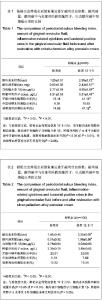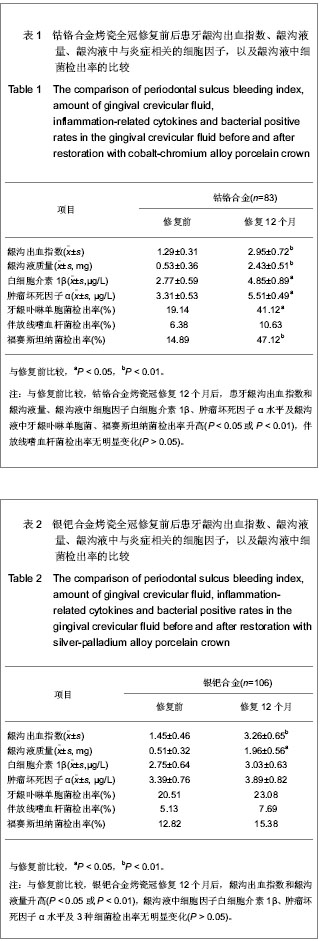| [1] Zhao YM.Beijing:Renminc Weisheng Chubanshe. 2012:76, 78.赵铱民.口腔修复学[M]. 7版,北京:人民卫生出版社,2012:76,78.[2] Chen CY,Zhu HH.Shiyong Yixue Zahzi. 2011;27(22): 4174-4175.陈春英,朱怀红. 两种镍铬合金替代烤瓷冠对牙周组织影响的对比分析[J].实用医学杂志,2011,27(22):4174-4175.[3] Li JW,Li CJ,Lü J,et al.Zhongguo Zuzhi Gongcheng Yanjiu yu Linchuang Kangfu. 2011;15(47):8873-8876.李菁文,李春洁,吕俊,等.贵金属、镍铬合金烤瓷修复体与中国人牙周组织健康关系的系统评价[J].中国组织工程研究与临床康复,2011,15(47):8873-8876.[4] Sui LN,Yu LY.Cailiao Daobao. 2012;12(10):89-91.隋丽娜,于立岩.新型金属烤瓷粉的制备与性能研究[J].材料导报, 2012,12(10):89-91.[5] Yi Z,Hao YQ,Wu L,et al.Zhongguo Shiyong Kouqiangke Zazhi. 2012;5(6):354-357.伊哲,郝玉全,吴琳,等.钯银合金与钴铬合金的机械性能及金瓷结合强度比较研究[J].中国实用口腔科杂志,2012,5(6):354-357.[6] Xia G,Chen B,Xu BY,et al.Zhonghua Kouqiang Yixue Zazhi. 2012;47(3):148-152.夏刚,陈波,徐碧瑶,等.戴用镍铬合金烤瓷冠对免疫功能影响的横断面研究[J].中华口腔医学杂志,2012,47(3):148-152.[7] Li HZ.Zhongguo Meirong Yixue. 2012;21(z1):1.李鸿志.探讨镍铬烤瓷牙的临床应用和不良反应[J].中国美容医学,2012, 21(z1):1.[8] Cao XM,Wang Y,Xia G,et al.Huaxi Kouqiang Yixue Zazhi. 2012;30(2):165-168.曹新明,王珏,夏刚,等.佩戴镍铬合金烤瓷冠对尿镍铬水平影响的前瞻性随访研究[J].华西口腔医学杂志, 2012, 30(2): 165-168.[9] Li HF. Shiyong Kouqiang Yixue Zazhi. 2011;17(4): 612-614.李鸿飞.含钛镍铬合金、钴铬合金、高金合金烤瓷牙的临床应用比较[J].实用口腔医学杂志,2011,17(4): 612-614.[10] Wu ZK,Xu S,Li N. Huaxi Kouqiang Yixue Zazhi. 2011;29(6): 568-575.吴芝凯,许胜,李宁. 固态相变对钴铬合金的金瓷匹配性的影响[J].华西口腔医学杂志,2011,29(6):568-575.[11] Li J,Gong ZJ,Chen GP,et al. Kouqiang Yixue. 2010;30(9): 544-546.李剑,龚中坚,陈国平,等. CAD/CAM氧化锆烤瓷后牙固定桥与常规烤瓷固定桥的临床应用比较研究[J].口腔医学,2010,30(9): 544-546.[12] Ji MM.Zhongguo Xiandai Yiyao Zazhi. 2009;11(11):93-94.吉蒙蒙.高金合金烤瓷修复体的临床疗效观察[J].中国现代医药杂志,2009,11(11):93-94.[13] Xu WX,Yuan JM,Su JS.Zhong Meirong Yixue. 2010;19(9): 1406-1409.许卫星,袁剑鸣,苏剑生.金属烤瓷全冠对基牙牙周组织健康影响的研究回顾[J].中国美容医学,2010,19(9):1406-1409.[14] Cao CF. Beijing:Renminc Weisheng Chubanshe. 2003:95.曹采方.牙周病学[M].2版.北京:人民卫生出版社,2003:95.[15] Kimura S,Ooshima T,Takiguchi M,et al.Periodon-topathic bacterial infection in childhood.J Periodontal.2002;73(1): 20-26.[16] Ashimoto A,Chen C,Bakker I,et al.Polymerase chain reaction detection of 8 putative periodontal pathogens in subgingival plaque of gingivitis and advanced periodontitis lesions.Oral Microbiol Immunol.1996;11(4):266-273.[17] Elter JR,Champagne CME,Offenbaeher S,et al.Relationship of periodontal disease and tooth loss to prevalence of coronary heart disease.J Periodontol,2004,75(6):782-790.[18] Cairo F,Gaeta C,Dorigo W,et al.Periodontal pathogens in atheromatous plaques.A controlled clinical and laboratory trial.J Periodontal Res.2004;39(6):442-446.[19] Donovan TE,Cho GC.Soft tissue management with metal-ceramic and all-ceramic restorationa.J Calif Dent Assoc.1998;26(2):107.[20] Yuan YM,Sun MY. Xiandai Kouqiang Yixue Zazhi. 1999; 13(2):32-33.袁玉妹,孙默予.金属烤瓷修复体远期疗效的评价—附65例复查报告[J].现代口腔医学杂志,1999,13(2):32-33.[21] Meng HX. Beijing:Renminc Weisheng Chubanshe. 2008: 118-120.孟焕新.牙周病学[M]. 3版. 北京:人民卫生出版社, 2008: 118-120.[22] Pan DD,Zhang XY. Kouqiang Cailia Qixie Zazhi. 2005;14(2): 83-85.潘冬冬,张修银.金属烤瓷冠修复体对牙龈健康的影响因素[J].口腔材料器械杂志,2005,14(2):83-85.[23] Zhang Y. Shiyong Kouqiang Yixue Zazhi. 2010;26(2):244- 246.张英.3种全冠修复体对基牙龈沟液中酶水平的影响[J].实用口腔医学杂志,2010,26(2):244-246.[24] Li JH,Chen ZH.Fujian Yiyao Zazhi. 2010;32(6):25-26.李建辉,陈詹宏.高金合金、钴铬合金烤瓷冠对牙龈健康影响的分析[J].福建医药杂志,2010,32(6):25-26.[25] Al-Salehi SK,Hatton PV,Johnson A,et al.The effect of hydrogen peroxide concentration on metal ion release from dental casting alloys.J Oral Rehabil.2008;35(4):276-282.[26] López-Alías JF,Martinez-Gomis J,Anglada JM,et al.Ion release from dental casting alloys as assessed by a continuous flow system:Nutritional and toxicological implications.Dent Mater.2006;22(9):832-837.[27] Chen YG,Lu PJ,Wang Y,et al. Kouqiang Yixue. 2011;31(6): 321-323.陈永刚,吕培军,王勇,等. 全冠修复体边缘密合度的数字化辅助评价方法[J].口腔医学,2011,31(6):321-323.[28] Wu HY,He HM,Wang ZY,et al.Yati Yasui Yazhoubingxue Zazhi. 2003;13(12):700-702.武红艳,何惠明,王忠义,等.两种冠边缘设计对龈沟液中IL-6和TNF-α表达的影响[J].牙体牙髓牙周病学杂志,2003,13(12): 700-702.[29] Zhao T,Peng C.Zhonghua Kouqiang Yixue Yanjiu Zazhi. 2010; 4(1):17-21.赵彤,彭诚. 非贵金属烤瓷冠修复患者龈沟液中白细胞介素-1β及天门冬氨酸转氨酶水平研究[J]. 中华口腔医学研究杂志:电子版,2010,4(1):17-21.[30] Chang CR,Pan YP,Zhong HM,et al. Kouqiang Yixue Yanjiu. 2010;26(2):208-211.常春荣,潘亚萍,钟慧敏,等. 洁治和根面平整术对冠心病合并牙周炎患者血清及龈沟液中白介素-1β的影响[J]. 口腔医学研究,2010,26(2):208-211.[31] Hao L,Dai M,Shuai L,et al.Shengwu Guke Cailiao yu Linchuang Yanjiu. 2006;3(6):8-10.郝亮,戴闽,帅浪,等.金属离子诱导人单核细胞凋亡并释放肿瘤坏死因子的实验研究[J].生物骨科材料与临床研究,2006,3(6): 8-10.[32] Thiha K,Takeuchi Y,Umeda M,et al.Identification of periodontopathic bacteria in gingival tissue of Japanese periodontitis patients.Oral Microbiol Immunol.2007;22(3):201.[33] Ye F,Liao XP,Liu XQ,et al.Shiyong Zhongxiyi Jiehe Linchuang. 2012;12(3):1-3.叶芳,廖小平,刘晓琼,等.两种金属烤瓷冠对牙周组织影响的比较研究[J].实用中西医结合临床,2012,12(3):1-3.[34] He ZF,Li L,Lin L,et al.Linchuang Kouqiang Yixue Zazhi. 2010; 26(6):349-350.何振锋,李莉,林岚,等. 69例烤瓷冠不同颈缘位置对牙周健康的对比观察[J].临床口腔医学杂志,2010,26(6):349-350.[35] Shen L,Xiang D,Zhong LF. Zhongguo Shiyong Kouqiangke Zazhi. 2009;2(2):94-96.沈磊,项东,钟丽芳.钴铬合金烤瓷全冠修复对患牙牙周组织影响的研究[J].中国实用口腔科杂志,2009,2(2):94-96. |

